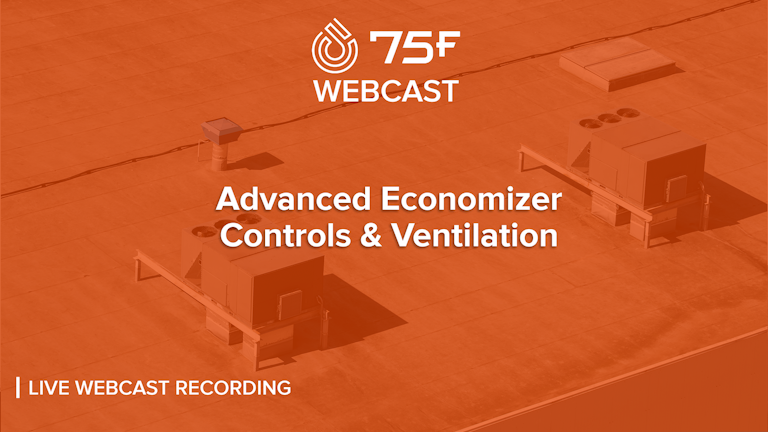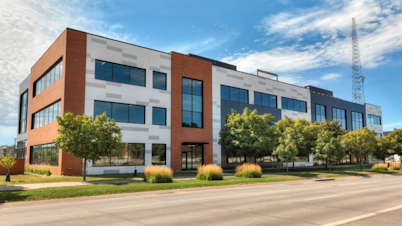
Healthier Buildings Series: Advanced Economizer Controls and Ventilation
This installment of 75F's Healthier Buildings webinar series walks viewers through the latest news surrounding airborne COVID-19 transmission, and how advanced economizer controls can help you implement increased outdoor air (OA) ventilation.
75F Chief Evangelist, Bob French, teams up for the session with Mya Holzemer, National Sales Engineer at Automation Components, Inc. (ACI). Holzemer offers viewers practical information on ACI's high-performance sensors, building pressure, and considerations for sensors relative to increased outdoor air ventilation.
For a PDF copy of the presentation slides, click here. Continue reading for a recap of some of the topics covered in this session.
NYT: Experts Call on W.H.O to Recognize Risk of Airborne Transmission
In early July, The New York Times published an article highlighting the increasing call from researchers for the World Health Organization (W.H.O.) to publicly recognize the danger of airborne COVID-19 transmission.
The article cited an open letter to the W.H.O. that 239 experts signed, which urged the global organization to publicize proper warnings of the danger of airborne COVID-19 transmission. A few days later, the organization did acknowledge emerging evidence that COVID-19 is airborne.
Transmission via infectious aerosols that can linger in the air is a concept that researchers and HVAC industry experts embraced early on in the pandemic, including the American Society of Heating, Refrigerating, and Air-conditioning Engineers.
"Transmission of SARS-CoV-2 through the air is sufficiently likely that airborne exposure to the virus should be controlled. Changes to building operations, including the operation of heating, ventilating, and air-conditioning systems, can reduce airborne exposures," — ASHRAE Epidemic Task Force.
Among the recommendations ASHRAE offers up to mitigate this risk is opening OA dampers as far as system capacity will allow and disabling demand-control ventilation for the highest ratio of OA as possible. For detailed descriptions on recommended control sequences and how to implement them efficiently, please reference previous Healthier Buildings webcast series installments.
On the Roof with Matt Blount
Because this webcast digs into the rooftop unit (RTU) in detail, 75F asked our Director of Support and Training, Matt Blount, to give viewers a video tour of the inside of an RTU for context. Find that clip below!
Outside Air Optimization for Epidemic Mode and Efficiency
Implementing the guidelines detailed above has complicated a once simple concept: How much OA is needed in your space? Presenter Bob French details the sequences that change the fraction of required OA:
Normal Operation — Minimum ventilation requirements, determined by design parameters including size of the space and maximum occupancy.
Demand-Control Ventilation — Improving efficiency by determining actual occupancy instead of maximum occupancy assumption.
75F® Epidemic Mode™ — Pre- and post-purging and enhanced ventilation that follows ASHRAE guidance.
Free Cooling — Using OA to cool spaces instead of DX or CW cooling.
Building pressure management — Adjusting OA when exhaust fans, such as those in a kitchen, would create negative pressure.
Find Bob's detailed analysis of these sequences at 38 minutes into the webinar recording, or on slide 25 of the presentation PDF.
Q&A
At every Healthier Buildings webcast session, our viewers are asking insightful questions. We've compiled a few of them with our answers below.
"What kind of optimization is available for increased filtration as well as ventilation?" — Annemarie
Thankfully, optimizing for filtration is complementary to optimizing for ventilation. You want to have the high airflow possible to purge any airborne particles before and after occupancy, and then have your system running at a more energy-efficient set point.
"How do you recommend handling the additional OA load if your current system is not designed to handle it?" — Jim
Pretty much all buildings can handle the additional OA load for most of the year when the outside air conditions are not extreme. The problem is really evident when the outside weather is more extreme (close to the design day) and the building load is all the HVAC equipment can handle. That is why you need a control system like 75F that can adapt to the actual available capacity and automatically ramp down the OA using a machine learning.
"Has the range of inside temperature been changed by new guidance to meet more ventilation needs for the pandemic?" — Vahab
The guidance has not changed the range of inside temperatures. Research shows that COVID-19 particles survive longer in warm, dry indoor environments compared to cold, wet ones. However, ASHRAE recommends keeping relative humidity indoors between 40 and 60 percent — according to research, more humid environments encourage larger aerosol droplets to form, thus weighing them down onto surfaces more quickly, where they can be disinfected and wiped away.
"Do ultraviolet light devices work for virus control?" — Monte
UV light has been used in hospital infection rooms to prevent airborne spread. Studies have shown that decimation of COVID-19 is based on light intensity, duration of exposure, temperature, and humidity. The current consensus is that airborne particles will not be close enough to a light for long enough to have any effect in commercial buildings.











